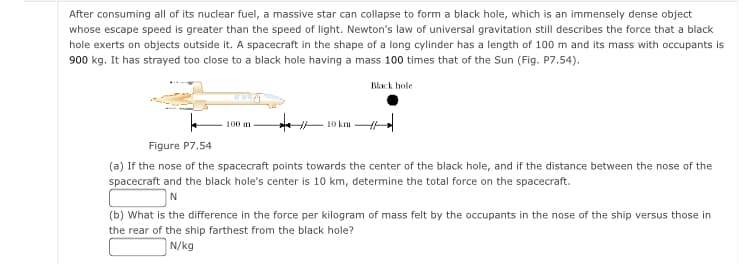After consuming all of its nuclear fuel, a massive star can collapse to form a black hole, which is an immensely dense object whose escape speed is greater than the speed of light. Newton's law of universal gravitation still describes the force that a black hole exerts on objects outside it. A spacecraft in the shape of a long cylinder has a length of 100 m and its mass with occupants is 900 kg. It has strayed too close to a black hole having a mass 100 times that of the Sun (Fig. P7.54). Black hole 10 km- 100 m- Figure P7.54 (a) If the nose of the spacecraft points towards the center of the black hole, and if the distance between the nose of the spacecraft and the black hole's center is 10 km, determine the total force on the spacecraft. (b) What is the difference in the force per kilogram of mass felt by the occupants in the nose of the ship versus those in the rear of the ship farthest from the black hole? N/kg
Kinematics
A machine is a device that accepts energy in some available form and utilizes it to do a type of work. Energy, work, or power has to be transferred from one mechanical part to another to run a machine. While the transfer of energy between two machine parts, those two parts experience a relative motion with each other. Studying such relative motions is termed kinematics.
Kinetic Energy and Work-Energy Theorem
In physics, work is the product of the net force in direction of the displacement and the magnitude of this displacement or it can also be defined as the energy transfer of an object when it is moved for a distance due to the forces acting on it in the direction of displacement and perpendicular to the displacement which is called the normal force. Energy is the capacity of any object doing work. The SI unit of work is joule and energy is Joule. This principle follows the second law of Newton's law of motion where the net force causes the acceleration of an object. The force of gravity which is downward force and the normal force acting on an object which is perpendicular to the object are equal in magnitude but opposite to the direction, so while determining the net force, these two components cancel out. The net force is the horizontal component of the force and in our explanation, we consider everything as frictionless surface since friction should also be calculated while called the work-energy component of the object. The two most basics of energy classification are potential energy and kinetic energy. There are various kinds of kinetic energy like chemical, mechanical, thermal, nuclear, electrical, radiant energy, and so on. The work is done when there is a change in energy and it mainly depends on the application of force and movement of the object. Let us say how much work is needed to lift a 5kg ball 5m high. Work is mathematically represented as Force ×Displacement. So it will be 5kg times the gravitational constant on earth and the distance moved by the object. Wnet=Fnet times Displacement.

Trending now
This is a popular solution!
Step by step
Solved in 2 steps with 2 images









